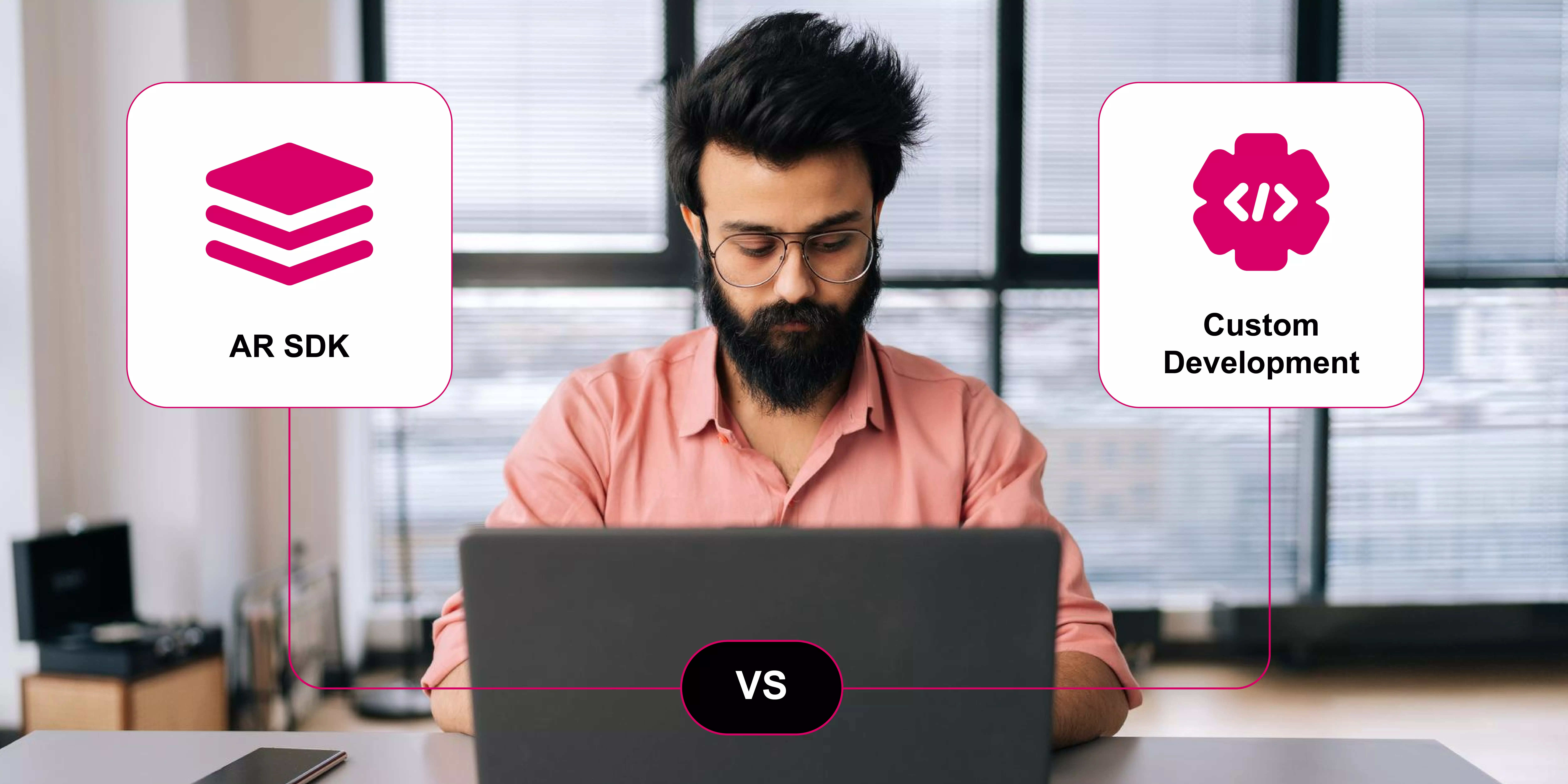
AR SDK vs. custom development: How to choose the right approach



Augmented reality has helped businesses and online sellers to increase their revenue, drive more sales, and boost conversion rates by offering their customers engaging and immersive online shopping experiences. However, selecting the best way to build and create AR features and capabilities is still a confusing and debated task.
In this blog, I have provided you with detailed information on how to select the best way of AR development, enabling you to understand the best way of AR development. I have also provided you with detailed information on two different methods, AR SDK and custom development, and their benefits and limitations.
What is an AR SDK?
An AR SDK is a software development kit that consists of a set of tools, libraries, and documentation that can be used by developers to create various AR-based applications. By using these SDKs, brands and businesses can handle various complex tasks of layering digital content, such as 3D models or animations, onto the real world, which can be viewed through devices such as smartphones or AR headsets.
Some of its main components include APIs or frameworks, content rendering, tracking and localization, and scene recognition, enabling brands to provide their customers with a realistic and engaging experience. Some advanced AR SDKs also help online sellers and businesses to provide their clients with an immersive experience by detecting their facial expressions in order to interpret the environment and create a stable and interactive AR experience.
{{component="/internal/widgets"}}
Benefits and limitations of using AR SDK
Using any kind of method for application development brings both advantages and disadvantages for developers, as it may help in reducing the development cost and time, but may raise privacy issues. In this section, I will help you understand the benefits and limitations of using an AR SDK for your online platform, and whether using an AR SDK development method for app development is beneficial for your company or not.
Benefits
- Accelerated development: It helps developers decrease the development time by providing them with pre-built tools, libraries, and APIs that simplify the complex process of creating AR experiences. It also helps developers to increase the user experience by offering them advanced AR features, such as image tracking, plane detection, and 3D object tracking, without building them from the ground up.
- Simplified complexity: It helps developers to reduce the complexity of app development by making the development process more efficient and easier. It enables developers to handle the technical complexity, such as motion tracking, depth sensing, and lighting estimation, enabling them to focus on the creative and functional aspects during the application development process.
- Lower initial investment: By using the AR-based SDKs, developers can reduce the initial development cost of the application because it helps to simplify the development process by offering them ready-made tools. Apart from that, it also helps to reduce the initial cost of the application development, which is associated with the building of AR features and capabilities.
Limitations
- Privacy concerns: It requires the collection and analysis of data, including real-time environmental mapping and user information, which can raise privacy and security concerns related to customers. Therefore, using an AR SDK for application development can pose some potential user privacy concerns for end-users if data collection and analysis are not managed responsibly.
- Technical limitations: While using the AR SDK, developers can face some technical limitations, such as a maximum number of image targets or performance issues in less-than-ideal lighting conditions, which may cause issues during the application development process.
What is custom development?
The custom development process of an application includes multiple steps, such as designing, creating, and implementing software or digital solutions specifically tailored to meet the unique needs and goals of a particular user, business, or organization. By opting for a custom development method, businesses can fulfill the unique requirements of the company in order to meet the company's specific needs or workflow.
It also enables companies or brands to implement features and functionalities that mass-produced software cannot offer, helping them to stand out in the market and create a competitive edge. With the help of the custom app development process, businesses can meet the requirements of a personalized and engaging experience by offering their customers tailored solutions during online shopping.
Benefits and limitations of using custom AR development
Another method of application development is using custom code, which enables developers to create unique and personalized augmented reality experiences for their customers. However, using any application development comes with both advantages and disadvantages, which developers face during the development process. In this section, I will tell you about the benefits and limitations of using the custom development method that are faced or encountered by developers.
Benefits
- Unlimited customization: It provides developers with the advantage of performing complete customization of AR capabilities and features, enabling them to create custom AR solutions that are uniquely designed to align perfectly with your brand and specific business goals.
- Optimal performance: It allows developers to build from scratch for a specific purpose, which can be highly optimized for speed and responsiveness, providing their customers with a seamless user experience. It is very crucial for brands that require complex or highly interactive AR applications.
- High security: Using custom development will help developers to safeguard their app from hackers, because it will enable them to control the security protocols and build protections for their sensitive data from the ground up.
- Complete ownership: It provides developers with full ownership of all the code and intellectual property, enabling them to rely on a third-party provider's long-term viability or pricing structure.
Limitations
- High development cost: Building a custom AR development requires a high development cost to hire experienced developers, designers, and 3D modelers, which can often be more expensive than a licensed SDK or no-code solution, and maintenance adds to the long-term costs.
- Expertise required: To build a completely custom AR experience, brands need to opt for people who have deep knowledge of AR technologies, 3D graphics, computer vision, and machine learning, which can be challenging for brands to hire experts at low costs.
Comparison table of AR SDK and custom development
How to choose the right AR development approach
Selecting the best way of AR development requires deciding on multiple factors, such as project needs and goals, development method, and appropriate tools and partners.
By carefully evaluating these factors, developers can build AR applications that align with business goals, user needs, budget, and target audience. In this section, I will tell you about the things or features that brands should consider while selecting the best way of AR development.
1. Define project and goals
Before selecting the development path, it is important to define the project’s goals, needs, and target audience, which will enable the company to understand their requirements and select the best option accordingly. Defining project goals will also help developers to set a realistic budget and timeline, enabling them to make the AR development process more efficient and cost-effective.
2. Choose development path
After defining the project needs and goals, it's time to select the best way of augmented reality development by looking for various AR platforms (GlamAR, ARKit, ARCore, WebAR), app type (native vs web), application types, and AR types. It will help the developers to make AR solutions more personalized based on the target audience and complexity, ensuring interactive and platform-optimized applications.
3. Select tools and partners
The last step to perform while selecting the best AR development method is to select the appropriate tool and partner by reviewing the portfolio and references of agencies to check the project success rate and check their references for client satisfaction. It will also help you to check integration tools and development tools that also align with your goals and needs.
Introducing GlamAR’s AR SDK for online sellers and businesses
GlamAR is an AR-based solution provider that helps beauty, makeup, and clothing brands to provide their clients with an engaging and immersive online shopping experience. It provides its clients with a pre-built AR-based SDK that offers multiple solutions, such as virtual try-ons, 3D configurators, and 360-degree viewers.
By using this AR-based SDK, businesses can provide their clients with realistic shopping experiences that help them bridge the gap between online and offline experiences. It enables them to make 3D models and 360-degree previews of the products by using 2D product images uploaded by the brand on their portal.
It helps brands to generate more revenue by helping them to increase their engagement by 94%, reduce return rate by 40%, and drive more conversions by 45%. Along with that, the SDK is backed by enterprise-grade security and scale, offering SOC 2, GDPR, and ISO 27001. Therefore, using GlamAR’s AR SDK will enable businesses to provide their customers with a real-time user experience during online shopping.
Conclusion
Augmented reality development is a need of today’s world because it helps businesses to provide their customers with engaging and immersive experiences during online shopping. However, building AR features and capabilities can be done in two different ways, AR-based SDKs or custom development, depending on the needs of the project.
In this blog, I have provided you with a complete guide on which method to choose to perform AR development, along with its benefits and limitations, providing you with complete information. Also, I have provided you with brief information on an AR-based SDK provider, GlamAR, which deals with jewelry, fashion, beauty, and accessories brands, providing them with advanced AR features.
{{component="/internal/widgets"}}
An augmented reality-based SDK is a collection of pre-built tools, libraries, and frameworks, which helps e-commerce brands and businesses to provide their customers with engaging shopping experience by offering them advanced AR features.
By using an AR-based SDK, brands will get multiple benefits, such as faster time-to-market, lower upfront costs, regular updates, ongoing vendor support, and scalable integration options, enabling them to provide their customers with advanced features, like facial tracking, object recognition, and platform compatibility.
A brand should opt for custom AR development when it requires a need of highly unique development method with complete control over the tech stack, along with specialized performance needs, or wishes to own all underlying intellectual property.
There are multiple SDK-based solutions that usually cost significantly less upfront because of their reusable components and prebuilt features, while custom AR involves a higher initial investment, more R&D time, and ongoing costs, but offers greater flexibility and ownership.
Yes, you can migrate an AR-based SDK solution to a custom-built platform by rewriting and re-architecting core tracking and rendering modules' features, depending on your needs and requirements.
An AR-based SDK solution offers continuous coverage, covering bug fixes and new features; on the other hand, custom solutions require internal teams for maintenance, updates, and troubleshooting, often increasing long-term resource commitments.



















